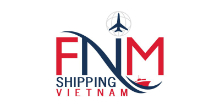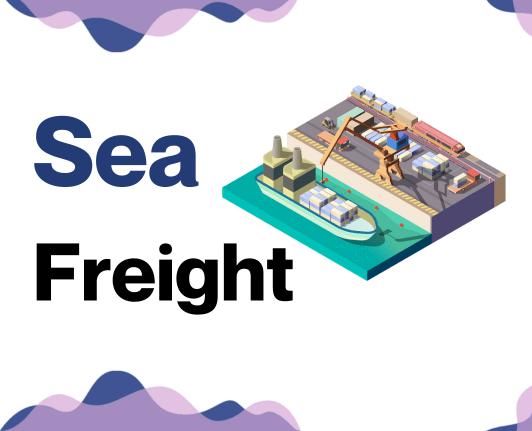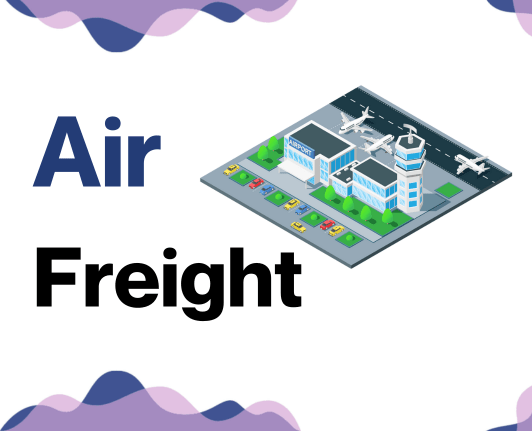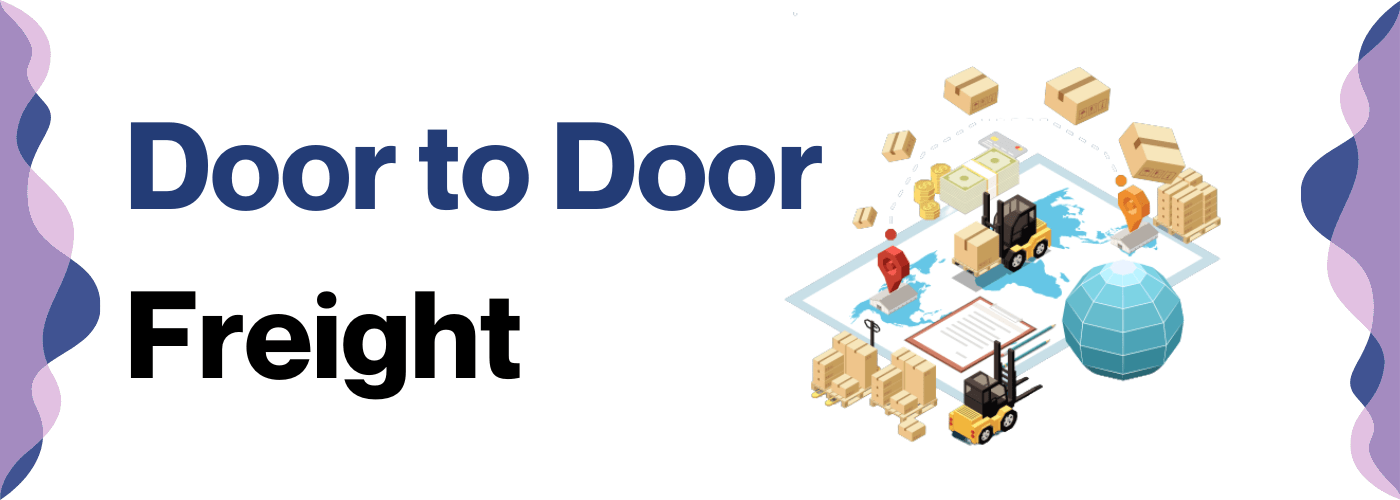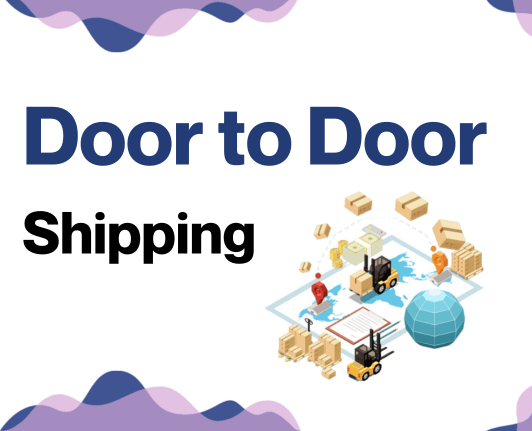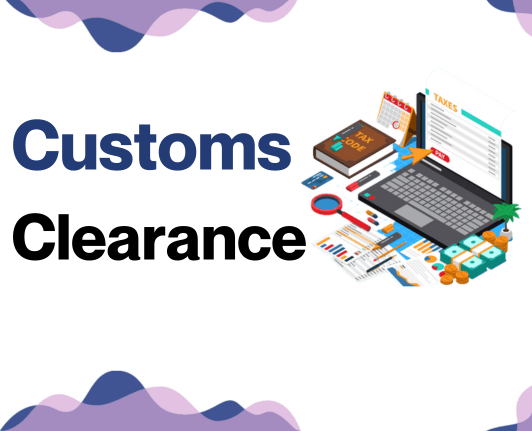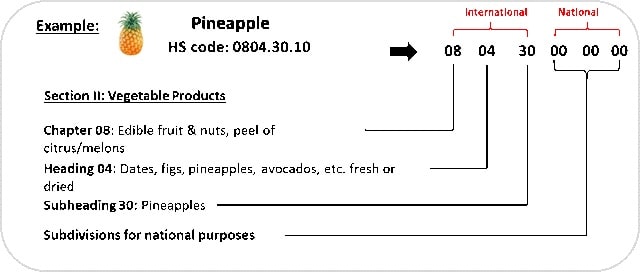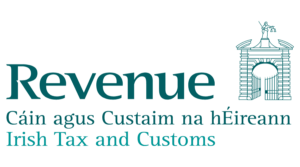Shipping goods between Ireland and Vietnam might sound as challenging as finding a leprechaun at the end of a rainbow, but it doesn't have to be! Comprehending the vast network of rates, transit times, and complex customs regulations can be overwhelming, even for seasoned businesses. This guide offers a comprehensive run-down on all that you need to grasp, from different types of transport choices like air, sea, road, and rail freight, to the nitty-gritty of customs clearance, duties, taxes, and practical tips designed for businesses just like yours. If the process still feels overwhelming, let FNM Vietnam handle it for you! With our expertise as an international freight forwarder, we turn your shipping challenges into stellar business success, managing every step for a smooth, hassle-free experience.
Which are the different modes of transportation between Vietnam and Ireland?
When it comes to shipping from Vietnam to Ireland, picture it like a thrilling global chess game. Air transport swoops in swiftly, the knight of the board - fast but pricey. On the other hand, sea freight is the sturdy rook, slower but economical, covering massive distances with ease. Your checkmate? Choosing wisely to match your timeframes, budget, and cargo needs with due consideration of the vast ocean and sky distance between both countries. How you move on this 'chessboard' can make all the difference in your international shipping success.
How can FNM Vietnam help?
Looking to ship goods from Vietnam to Ireland with smooth sailing? FNM Vietnam is your trusted partner. We handle the entire process end-to-end, from organizing transport to dealing with the nitty-gritty of customs. So, why wait? Contact our expert consultants for a free, no-obligation estimate in less than 24 hours. Let's make global trade easy, together.
FNM Vietnam Tip: Sea freight might be the best solution for you if:
- You're moving big loads or large items. Sea freight offers roomy, cost-effective solutions.
- Your shipment isn't time-critical. Ocean routes take longer but are often more reliable.
- Your supply chain links major ports, tapping into a broad network of sea lanes.
Sea freight between Vietnam and Ireland
Ocean shipping between Vietnam and Ireland is a thriving conduit of trade, with bustling ports like Ho Chi Minh City and Dublin acting as the hearts of their industrial landscapes. From electronics to textiles, the sea vessels ferry vast volumes of goods, making the most of the cost-effectiveness of sea freight despite its slower pace.
However, this route can be a choppy sea for shippers and businesses unfamiliar with its unique challenges. Picture this, it's like a new sailor trying to chart a course in stormy weather. That's where understanding best practices and specifications come into play. So, if you've ever felt like a novice sailor lost at sea while shipping between these two nations, don't worry. This guide is your trusty compass, ready to lead you through the fog. It will uncover the do's, don'ts, and case-specific strategies to streamline your maritime trade journey between Vietnam and Ireland. So, let's set sail together on this exciting voyage of discovery!
Main shipping ports in Vietnam
Port of Ho Chi Minh City
Location and Volume: Located in the southern part of Vietnam, this port plays a vital role in the trade activities not only within the region but for most of the country as a whole. With a shipping volume of 7 million TEU, it's by far the busiest port in Vietnam.
Key Trading Partners and Strategic Importance: Its primary trading partners are China, Japan, South Korea, and the United States. Ho Chi Minh City port's strategic location makes it an essential hub for transpacific shipping and a pivot point in Southeast Asia.
Context for Businesses: If you're aiming to tap into markets within Asia or extend your operations toward North America, the Port of Ho Chi Minh City, with its expansive shipping volume and wide-reaching network, could be an ideal choice.
Port of Hai Phong
Location and Volume: Found in Northern Vietnam, Port of Hai Phong works as a significant gateway for northern provinces. It manages a shipping volume of more than 2 million TEU annually.
Key Trading Partners and Strategic Importance: This port primarily trades with other Asian countries, including China, South Korea, and Singapore. Its significance is reflected in its role as a fundamental terminal for exports destined for these economies.
Context for Businesses: If your business operations majorly involve economies like China or South Korea, the Port of Hai Phong could serve as a crucial component in your logistics strategy due to its strategic placement and strong connection with these markets.
Port of Da Nang
Location and Volume: Situated at the central coast of Vietnam, Port of Da Nang is another significant port, handling about 500,000 TEU annually.
Key Trading Partners and Strategic Importance: The Port of Da Nang mainly engages with countries like China, South Korea, and also involves trade with American and European countries. Situated at a central oceanic crossroads, it carries strategic importance to many international routes.
Context for Businesses: If your goal is to broaden your reach in both Asian and Western markets, you should consider the Port of Da Nang as an important part of your shipping strategy, thanks to its central location and versatile reach.
Port of Quy Nhon
Location and Volume: Found in Binh Dinh Province, the Port of Quy Nhon embodies an important role for the middle and highland regions of the country. This port sees an annual shipping volume of around 300,000 TEU.
Key Trading Partners and Strategic Importance: Quy Nhon majorly engages with trading partners across Asia like China, Japan, and India among others. Its primary strategic importance lies in serving the trade needs of deep-land provinces.
Context for Businesses: If you're exploring Asian markets, especially those inland and prefer to avoid congested major ports, Port of Quy Nhon may serve as an attractive choice due to its unimpeded access and regional connections.
Vung Tau Port
Location and Volume: Situated near Ho Chi Minh City, Vung Tau Port deals with approximately 1.7 million TEU annually, providing crucial maritime services for the surrounding industries.
Key Trading Partners and Strategic Importance: Vung Tau trades mainly with China, India, and countries within the ASEAN region. It is strategically important for regional trade in Southeast Asia and acts as a key service hub for offshore oil activities.
Context for Businesses: If you're engaging in the energy sector or targeting the ASEAN market, choosing Vung Tau Port could significantly optimize your logistics, considering its proximity to Ho Chi Minh City and oil industries.
Port of Cai Mep
Location and Volume: This deep-sea port located in the Ba Ria-Vung Tau province can accommodate large vessels and deals with about 2.5 million TEU annually.
Key Trading Partners and Strategic Importance: Key trading partners include other ASEAN members, China, the USA, and Europe. The capacity to accommodate mega-vessels makes the port significantly strategic for long-haul trade routes.
Context for Businesses: If your business involves large volumes of goods destined towards Western or Asian markets, the Port of Cai Mep might prove to be a beneficial part of your logistics plan due to its ability to support large vessels and its global connections.
Main shipping ports in Ireland
Port of Cork
- Location and Volume: Situated in the southwest of Ireland, the Port of Cork is a significant facilitator of economic activity within the region. It boasts a shipping volume of approximatively 10 million tons of cargo annually.
- Key Trading Partners and Strategic Importance: Primarily, the port maintains robust trade relations with the European Union, the United States and the Middle East. Its strategic importance is magnified due to being the only port in Ireland with direct services to all six continents.
- Context for Businesses: If your aim is to penetrate the European and Middle Eastern markets, the Port of Cork can form an integral part of your shipping strategy due to its convenient geographic location and wide-reaching cargo services.
Dublin Port
- Location and Volume: Embodied in the heart of Ireland's capital city, Dublin Port is the largest port in the country, accounting for over 40% of the Ireland’s trade, handling over 38 million tons of cargo per year.
- Key Trading Partners and Strategic Importance: Dublin Port holds a pivotal role in trading with European countries, mainly with the United Kingdom, and is strategically important as it accommodates 84 ship lines.
- Context for Businesses: With a broad range of shipping lines and its central location, Dublin Port can accommodate your business needs if you're targeting diverse European markets, placing particular emphasis on trade with the UK.
Port of Waterford
- Location and Volume: Nestled in the southeast of Ireland, Port of Waterford handles around 10% of Ireland’s port traffic with more than 1.5 million tons of cargo a year.
- Key Trading Partners and Strategic Importance: The port has sturdy trade relations with European countries, with a significant emphasis on Nordic countries. It holds strategic importance as the closest Irish multi-modal port to mainland Europe offering both RoRo and LoLo services.
- Context for Businesses: For businesses focused on scaling operations within the Nordic countries, the Port of Waterford is a strategic addition to your plan due to its specific shipping facilities and proximity to mainland Europe.
Shannon Foynes Port
- Location and Volume: Located on the west coast of Ireland, Shannon Foynes is an essential deep-water bulk port, handling over 10 million tons of cargo annually.
- Key Trading Partners and Strategic Importance: Primary trading partners for Shannon Foynes are North America and the United Kingdom. It is of strategic importance due to its deepwater capabilities, allowing it to accommodate larger vessels.
- Context for Businesses: If your cargo primarily includes bulk commodities, Shannon Foynes is a valuable addition to your international shipping strategy due to its deep-water facilities and strong ties with North America and the UK.
Port of Galway
- Location and Volume: The Port of Galway is strategically located on the west coast of Ireland. It deals primarily in general bulk and has an annual throughput of over half a million tonnes.
- Key Trading Partners and Strategic Importance: Galway's key trading partners are within Europe, and the port holds strategic importance as a regional gateway and as a bi-directional trade facilitator for businesses across western Ireland.
- Context for Businesses: If your objectives include a focus on regional trade within Europe, the Port of Galway stands as a reliable solution due to its role as a pivotal hub for western Ireland.
Port of Rosslare
- Location and Volume: Positioned in the southeast corner of Ireland, Rosslare Europort as it's also known, handles over 500,000 units of freight each year and is one of Ireland's primary passenger ports.
- Key Trading Partners and Strategic Importance: Having strong trading relationships with France, Spain, and the United Kingdom, Rosslare is distinctly important thanks to its ferry connections to Europe, particularly after Brexit.
- Context for Businesses: If your shipping needs include high volumes of passenger and Roll-on/Roll-off RoRo traffic, Port of Rosslare can significantly contribute to your European-focused shipping strategy through its excellent passenger handling capacity and ferry connections.
Should I choose FCL or LCL when shipping between Vietnam and Ireland?
Embarking on the shipping journey from Vietnam to Ireland? It's make-or-break to select the right sea freight option. Both Full Container Load (FCL) and Less than Container Load (LCL) or consolidation, each present distinct advantages, shaping cost, delivery times, and ultimately the success of your operation. Prepare to dive into the vital differences between FCL and LCL and decide intelligently, considering your unique shipping needs. Remember, your choice is a strategic move, not a mere checkbox. The perfect decision awaits!
LCL: Less than Container Load
Definition: Less than Container Load (LCL) shipping is a cost-effective solution for transporting smaller volumes of goods. In LCL shipment, multiple shipments from different exporters are consolidated into one container for transit.
When to Use: LCL is better for low-volume shipments that don't require a full container. If your cargo is less than 13, 14, or 15 Cubic Meters (CBM), opting for LCL can be more economical.
Example: Let's say you own a clothing business in Vietnam and have received an order for 100 coats that takes up 10 CBM. Instead of booking an entire container, you would use an LCL freight service to share container space with other shippers, reducing your shipping costs significantly.
Cost Implications: LCL often provides a more flexible pricing structure, where you essentially pay for the space your cargo occupies, as opposed to paying for an entire container. However, keep in mind that there may be additional fees related to customs, handling, and delivery procedures that could increase your overall shipping expenditure.
FCL: Full Container Load
Definition: FCL, or Full Container Load, describes a shipment that fills an entire container, often in the sizes of 20'ft or 40'ft. This is a mode of transport used in sea freight, where your goods - in one intact unit - go from point A to point B.
When to Use: FCL is optimal when the shipment volume is above 13-15 cubic meters (CBM). This is because the large volume ensures that you're getting the most out of your container space, making it a cost-effective solution.
Example: Let's say, for instance, you're a furniture manufacturer in Vietnam sending an order to a major distributor in Ireland. Your units are large and heavy, filling a whole 20'ft container. In this case, opting for FCL shipping guarantees the safety of your single, sealed unit from origin to destination.
Cost Implications: FCL shipping quote typically has a lower cost per unit, as the all-inclusive rate is divided across the cargo inside. Essentially, the more you ship, the more you save. Furthermore, with FCL, your pricing tends less to be influenced by fluctuations in demand, making it a more stable, predictable choice financially.
Say goodbye to shipping headaches!
Streamline your sea freight journey with FNM Vietnam and make cargo shipping across borders a breeze. Deciding between consolidation and a full container? Our maritime freight experts will guide you, considering all the key factors - your cargo type, volume, budget, and delivery timelines. Trust FNM Vietnam's knowledge and experience to optimize your shipping process between Vietnam and Ireland. Reach out now for a free, no-obligation estimate tailored to your business needs. Unique solutions, just a click away.
How long does sea freight take between Vietnam and Ireland?
On average, sea freight from Vietnam to Ireland takes nearly 30 to 40 days. These transit times account for aspects like precise ports used, the weight, and the nature of the goods. It's suggested that for a customized quote based on your specific shipping requirements, you get in touch with a freight forwarder such as FNM Vietnam.
| Port in Vietnam | Port in Ireland | Average Transit Time (Days) |
| Ho Chi Minh | Dublin | 38 |
| Hai Phong | Dublin | 34 |
| Da Nang | Dublin | 37 |
| Qui Nhon | Dublin | 42 |
*Please note that the provided transit times are estimations and may vary based on various factors. It is preferable to consult with your freight forwarder for precise times.
How much does it cost to ship a container between Vietnam and Ireland?
Determining the precise ocean freight rates to ship a container between Vietnam and Ireland can be complex. It's like solving a jigsaw puzzle! The shipping cost isn't fixed - it swings broadly depending on the Point of Loading, Destination, carrier selected, nature of your goods, and even the whims of market fluctuations. Fear not, though! Our expert shipping specialists are adept at demystifying these variables and tailoring quotes on a case-by-case basis. Rest assured, we're committed to providing you with the best rates for your unique shipping requirements.
Special transportation services
Out of Gauge (OOG) Container
Definition: An OOG container is a shipping option designed to accommodate out of gauge cargo —items too large to fit in standard containers due to their dimensions.
Suitable for: Typically, this method is best for transporting oversized equipment, industrial machinery, boats, and other large structures.
Examples: A large printing press from Hanoi or a yacht manufactured in Ha Long could be examples of out of gauge cargos necessitating an OOG container.
Why it might be the best choice for you: Considering the vast industrial market of Vietnam, if your business deals with oversized or bulky machinery, OOG could be your optimal choice.
Break Bulk
Definition: Break bulk refers to goods that must be loaded individually onto the vessel, rather than in a shipping container. These are typically large items that cannot be divided into smaller units for shipment.
Suitable for: Ideal for large or irregularly shaped items, such as heavy machinery, construction materials, or even yachts.
Examples: Shipping oversized construction beams from Ho Chi Minh City or industrial cranes from Da Nang are situations when break bulk might be required.
Why it might be the best choice for you: If your business deals with oversized, non-containerized goods, break bulk presents an effective shipping solution.
Dry Bulk
Definition: Dry bulk shipping involves raw, unpackaged, loose cargo load that is poured directly into the vessel's hold rather than containerized.
Suitable for: It's primarily used for goods like grains, coal, metal ores, and other commodities.
Examples: Shipping rice from the Mekong Delta to Ireland or anthracite coal to the Irish market would make good use of dry bulk shipping.
Why it might be the best choice for you: If your business involves the transportation of raw, unprocessed, loose materials, focusing on dry bulk shipment could be highly beneficial.
Roll-on/Roll-off (Ro-Ro)
Definition: The Roll-on/Roll-off method, facilitated by a ro-ro vessel, allows wheeled cargo to roll onto and off the ship under its own power or with the assistance of a platform vehicle.
Suitable for: Predominantly used for the transportation of vehicles including cars, trucks, semi-trailer trucks, trailers, and railroad cars.
Examples: Exporting motorbikes from Hanoi, or vehicles produced in Vietnamese factories, to meet the automobile demand in Ireland.
Why it might be the best choice for you: If your business involves dealing with automobiles, plant equipment, or heavy machinery on wheels, the easy loading/unloading access of ro-ro shipping might be your go-to choice.
Reefer Containers
Definition: Reefer containers are refrigerated shipping containers used to transport temperature-sensitive cargo.
Suitable for: Used mainly for perishable goods, pharmaceuticals, and other products that need to be kept at a steady temperature.
Examples: Exporting Vietnamese tropical fruits like dragon fruit, rambutan, or lychee, or transporting pharmaceutical products to Ireland.
Why it might be the best choice for you: If your goods need to be kept at a specific temperature during transit, choosing reefer containers would ensure the safe and fresh arrival of your products.
If you're trading between Vietnam and Ireland and need assistance with managing your sea freight shipping, FNM Vietnam is always ready to lend a hand. We'll help you choose the most suitable shipping method for your business. Contact us today, and secure your free shipping quote in less than 24 hours.
FNM Vietnam Tip: Air freight might be the best solution for you if:
- You're on a tight schedule. Air freight delivers speed unmatched by other modes.
- Your cargo is under 2 CBM, a good fit for air's smaller capacity.
- Your destination is off the usual routes, making air's global network a key asset.
Air freight between Vietnam and Ireland
Air freight, soaring from Vietnam to Ireland, is agile, precise, and surprisingly cost-responsible for smaller, high-worth cargos. Picture this: your shipment of intricate ceramic goods or advanced tech-multipliers wrapped with the reliability of top-tier airway carriers, zooming your valuable consignments with express speed.
Now, selecting air freight might seem straightforward - just pick the right goods, make the payment, and you're good to go, right? Not so fast! Many savvy shippers are inching their way towards unexpected tribulations. An incorrect estimation of weight can hit you hard, skewing the whole budget. It's like baking a cake and forgetting about the invisible weight the sugar adds - a small miscalculation can leave a bitter aftertaste and a mess in the economics of your shipment. Stay tuned as we unpack battle-tested practices to sail smoothly amidst these hiccups.
Air Cargo vs Express Air Freight: How should I ship?
Deciding between air cargo and express air freight for your Vietnam-Ireland shipments? It's like choosing between a regular flight with other passengers (air cargo) or chartering an entire plane just for your goods (express air freight). Here's a quick, friendly guide to help untangle the service differences and clue you in on which might be the ultimate game-changer for your business shipping needs.
Should I choose Air Cargo between Vietnam and Ireland?
Choosing Air Cargo as your shipping method from Vietnam to Ireland could be the ideal solution for your business, particularly if your cargo weighs 100/150 kg (220/330 lbs) or more. Notably, airlines like Vietnam Airlines or Aer Lingus offer trusted freight services. With its cost-effectiveness and reliability, air cargo might suit your budgetary requirements despite slightly longer transit periods due to fixed schedules. Undoubtedly, this mode of transportation ensures a balance between cost and efficient delivery.
Should I choose Express Air Freight between Vietnam and Ireland?
Express air freight is a high-speed service using dedicated cargo planes, perfect for your compact shipments from Vietnam to Ireland. If you're transporting under 1 CBM or 100/150 kg of cargo, this might be your fastest, most efficient route. Firms like FedEx, UPS, and DHL specialize in these expedited systems. These experts handle everything from pickup in Vietnam to delivery in Ireland, streamlining your logistics. If speed and delivery window precision are top priorities, choosing express air freight can greatly benefit your business.
Main international airports in Vietnam
Tan Son Nhat International Airport
Cargo Volume: Handles more than 453,000 metric tons of cargo annually.
Key Trading Partners: The United States, China, Japan, South Korea.
Strategic Importance: Located in Ho Chi Minh City, one of the economic hubs of Vietnam.
Notable Features: Operates flights 24/7 and houses several large global forwarding agents.
For Your Business: The airport's location and ample cargo capacity make it an excellent choice if your business is shipping to or from southern Vietnam.
Noi Bai International Airport
Cargo Volume: Processes over 700,000 metric tons of cargo per year.
Key Trading Partners: United States, China, Japan, and South Korea.
Strategic Importance: Sits near Hanoi and the Red River Delta, some of the busiest production areas in Vietnam.
Notable Features: Offers a large cargo terminal with storage and preservation facilities.
For Your Business: If your business involves trade in northern Vietnam, Noi Bai's vast cargo facilities and strategic location offer convenience and accessibility.
Da Nang International Airport
Cargo Volume: Annually handles more than 100,000 metric tons of cargo.
Key Trading Partners: United States, China, Japan, Australia.
Strategic Importance: Centrally located, serving a key role in the East-West Economic Corridor (EWEC).
Notable Features: Has facilities capable of storing a variety of goods, including perishables and dangerous goods.
For Your Business: The airport's central location and connection to the EWEC makes it option for businesses with goods transiting through Southeast Asia.
Cần Thơ International Airport
Cargo Volume: Processes over 20,000 metric tons of cargo annually.
Key Trading Partners: Vietnam, Cambodia, Thailand, Malaysia.
Strategic Importance: Situated in the Mekong Delta region, surrounded by a significant agricultural area.
Notable Features: It is a newer airport, with modern facilities and a strategic focus on becoming a cargo hub.
For Your Business: The airport's proximity to one of the key agricultural areas makes it a prime option if your business involves trade in agricultural products.
Phu Quoc International Airport
Cargo Volume: Handles over 9,000 metric tons of cargo per year.
Key Trading Partners: Cambodia, Thailand, South Korea, India.
Strategic Importance: Located on Phu Quoc island, it connects the region to international markets.
Notable Features: Despite its smaller size, Phu Quoc Airport is well-equipped to handle a variety of cargoes.
For Your Business: This is a promising choice if your business is in the fishing industry or targets tourist hotspots, given the island's reputation in this area.
Main international airports in Ireland
Dublin Airport
Cargo Volume: With an annual handling capacity of over 140,000 tons, Dublin Airport is the busiest airport in Ireland in terms of freight.
Key Trading Partners: Key trading partners include the UK, USA, Germany, and China.
Strategic Importance: It's a crucial hub for Europe, connecting to over 180 destinations. Its strategic position on the western edge of Europe makes it an efficient gateway to North America.
Notable Features: It houses the Aer Lingus Cargo Terminal, providing various specialized services including temperature-controlled storage for perishable goods and secure areas for valuable cargo.
For Your Business: If your business predominantly ships to or from North America and requires specialized cargo handling, Dublin Airport might be a suitable choice. Its cargo facilities are equipped to handle many types of freight, ranging from pharmaceuticals to food and beverages.
Cork Airport
Cargo Volume: Handling over 2,500 tons annually, Cork Airport may appear small but it still remains important for regional trade.
Key Trading Partners: Key trading partners are mainly within the European Union, particularly the UK.
Strategic Importance: Although smaller in volume, Cork Airport is significant since it is the second-largest airport in Ireland and serves many regional and international destinations.
Notable Features: Has a range of logistics and handling services, including customs clearance and ground handling services, making operations smoother for businesses.
For Your Business: If you're interested in easier access to Southern Ireland and European markets, Cork Airport could be an advantageous partner due to its efficient logistical services and the ease of doing business.
Shannon Airport
Cargo Volume: Shannon Airport manages approximately 13,000 metric tons of cargo annually.
Key Trading Partners: Primary trade partners include the UK, USA, and Europe.
Strategic Importance: Shannon Airport is famous as the first airport in the world to offer full US Border Preclearance to passengers, allowing quicker access to the US market for Irish and European businesses.
Notable Features: Boasts a designated cargo terminal, offering secure storage and efficient cargo handling. It also offers US Customs and Border Protection preclearance services.
For Your Business: If a significant portion of your goods flow to the US, the preclearance feature at Shannon Airport can streamline your customs process, speeding up delivery times while reducing complexities with US customs clearance.
How long does air freight take between Vietnam and Ireland?
On average, shipping goods from Vietnam to Ireland by air freight takes approximately 5 to 8 days. However, there's a caveat: transit time will depend on a variety of factors, such as the specific airports involved, the weight of the shipment, and the nature of the goods being transported. Consequently, it's essential to keep in mind these variables when planning your shipping timeline. For precise shipment times tailored to your specific needs, consider seeking advice from an experienced freight forwarder like FNM Vietnam.
How much does it cost to ship a parcel between Vietnam and Ireland with air freight?
Shipping an air freight parcel from Vietnam to Ireland typically costs between €7 to €12 per kilogram. However, it's important to note that a multitude of factors influence the final cost. The distance from departure and arrival airports, parcel dimensions, weight, and the nature of goods all play a part in shaping the fee. Rest assured, our team works closely with each client to provide the most competitive rates. We offer customised quotes that take into account your unique shipping needs. Contact us to receive a free quote in less than 24 hours.
What is the difference between volumetric and gross weight?
Gross weight refers to an object's weight including packaging, pallets, and other containers, measured in kilograms. Volumetric weight, on the other hand, factors in the space an item takes up, alongside its actual weight.
Calculating gross weight in air cargo is straightforward. You simply place the item, with all packaging materials included, on a scale and read the number in kilograms. For example, if your package weighs 70 kg, this translates to roughly 154 lbs.
Calculating the volumetric weight is slightly different. You need to measure the length, width, and height of your package in meters and multiply these dimensions. Then, you multiply the result by the air freight volumetric factor of 167. For instance, let's say you have a package that measures 1 meter in length/width/height. This comes to 1 cubic meter. Multiplying by the volumetric factor of 167, this package has a volumetric weight of 167 kg, approximately 368 lbs.
Express Air Freight services use a slightly lower metric of 200 as the volumetric factor. Applying that to the same package measurements, you get a volumetric weight of 200 kg, or roughly 440 lbs.
Understanding gross and volumetric weight is critical because freight charges are calculated based on the higher of the two. This ensures you're accurately charged for both the weight and space your shipment occupies.
FNM Vietnam Tip: Door to Door might be the best solution for you if:
- You seek hassle-free shipping. Door-to-door manages the entire process for you.
- You like one go-to contact. A dedicated agent oversees your door-to-door shipment.
- You aim to limit cargo handling. Fewer transitions mean less risk of damage or loss.
Door to door between Vietnam and Ireland
Eager to ship directly from Vietnam to Ireland without fuss? Try our international door to door service, delivering convenience and efficiency rolled into one! Experience firsthand the appeal of seamless end-to-end shipping with reasonable prices and simplified logistics. Ready to discover more? Great, let's dive in!
Overview – Door to Door
Struggling with international logistics? Door to door shipping between Vietnam and Ireland is your answer. Imagine a stress-free solution that handles all the complexities of shipping, from customs clearance to delivery at your doorstep. Although a bit pricier, the convenience and time-saving this service offers are unmatched. It's no wonder FNM Vietnam's clients are all over it! Yes, shipping can be daunting, but it doesn't have to be. With our 'door to door' approach, your only job is to await your shipment's safe arrival! Take it easy, let us do the heavy lifting.
Why should I use a Door to Door service between Vietnam and Ireland?
Ever pondered how many cups of Irish coffee you could brew while entangled in transportation logistics? With a Door to Door service between Vietnam and Ireland, you won’t have to worry about your coffee getting cold. Here are five caffeine-fueled reasons why you might go for this service.
1. Stress-Beater: With this magic wand, your logistics stress evaporates instantly! Door to Door service drastically shrinks your responsibility list; from picking up your goods in Vietnam to delivering at the ideal spot in Ireland, the service safeguards every step.
2. Time Guardian: The clock ticks non-stop, but so does Door to Door service. Urgent shipment? No problem! With a keen focus on punctuality, this service can fast-track your delivery, ensuring your goods reach Ireland in record time.
3. Specialized Care: If you're transporting complex cargo, you’ll want a service that handles your goods like a newborn pup. Door to Door service provides the specialized care necessary for such delicate procedures.
4. Convenience Champion: You're busy with a gazillion things, and transportation shouldn't disrupt your rhythm. Door to Door service offers immense convenience by seamless handling of trucking from the initial pick-up to final deliverance in Ireland.
5. Destination Diva: Something satisfying about knowing your goods will make it to the exact location in Ireland, isn’t there? Well, Door to Door service promises just that, delivering your goods to your specified destination with zero fuss.
So go ahead, let us handle your shipments while you savor that delicious Irish coffee!
FNM Vietnam – Door to Door specialist between Vietnam and Ireland
Enjoy the benefits of stress-free shipping from Vietnam to Ireland with FNM Vietnam. Leveraging our extensive expertise, we cover every step of the process, from packing to customs clearance, utilizing all shipping methods. You won't have to lift a finger! Plus, a dedicated Account Executive is at your disposal. Reach out to us for a complimentary, no-obligation estimate in under 24 hours, or engage our seasoned consultants for free advice. Embrace tranquility in international shipping.
Customs clearance in Ireland for goods imported from Vietnam
Customs clearance is a tricky business! It's the essential process of getting official permission to import goods from Vietnam into Ireland, involving payments of duties, taxes, and adherence to quotas and licenses. The complexity often leads to unexpected fees and dreaded delays with your goods stuck in limbo. Not your idea of smooth sailing, right? Don't worry, we'll dig deeper into the labyrinth of bureaucracy in the next sections. Here's some good news – FNM Vietnam can help untangle this web. Need an estimate for your project budget? Just drop us a line with your goods' origin, value, and HS code (they're vital, by the way). We're pretty much seasoned at this, handling goods of all sorts from around the globe. So let's dive in and sort things out, shall we?
How to calculate duties & taxes when importing from Vietnam to Ireland?
Navigating the terrain of customs duties and taxes might appear challenging, but with the right knowledge, it becomes a straightforward and predictable process. The calculation of customs duties hinges on a few crucial variables which are the country of origin, the Harmonized System (HS) code of the merchandise, its customs value, the applicable tariff rate, and finally, any additional taxes and fees that your product may attract.
Embarking on this process requires that you first ascertain the country where the goods were manufactured or produced. This information kick-starts the calculation journey, serving as a key factor in anticipating the potential customs duties and taxes when importing from Vietnam to Ireland. With these pointers at your fingertips, you're well on your way to mastery of international shipping duties and taxes.
Step 1 - Identify the Country of Origin
Knowing your product's origin unlocks several perks. First, it determines the customs duties levied under Ireland's trade agreements. For instance, the EU-Vietnam Free Trade Agreement (FTA) lets goods from Vietnam enter Ireland at reduced tariffs or duty-free.
Second, it sets trade compliance standards. Vietnam, just like every country, has its unique manufacturing, safety, and quality norms. Knowing your product's origins helps confirm whether these norms align with Ireland's.
Third, identifying your goods' Country of Origin helps to prevent potential import restrictions. Take note, Ireland imposes specific limitations on certain Vietnam-made products.
Fourth, pinpointing where the goods were produced can streamline the import process and help avert custom delays.
Finally, you never have to get caught off-guard by unexpected import costs. Simply put, no nasty surprise tariffs.
Be mindful that details on Vietnam's exports to Ireland, the use of specific FTAs, and any import restrictions should be confirmed with a licensed customs broker or through the Customs Authority's direct channels. You'll thank us later when your shipping goes as smooth as an ocean breeze.
Step 2 - Find the HS Code of your product
The Harmonized System (HS) Code is a coded numerical representation of your product used in international trade. It facilitates the classification of goods for efficient customs-clearing processes. This universal language of product labeling is recognized and used by customs authorities across the globe.
Your supplier is typically the best start point in finding your product's HS Code. They're familiar with the products they export and know the pertinent regulations, hence can provide the correct HS Code.
If your supplier is unable to provide the HS Code, here is a step-by-step guide to obtain it:
1. Visit the Harmonized Tariff Schedule HS lookup tool
2. Enter the name of your product in the search bar.
3. Observe the Heading/Subheading column where you'll find the HS Code.
A word of caution: Accuracy is crucial when it comes to HS Codes. A wrong code could lead to customs hold-ups, delays in transport, and potentially even fines. Verify that the Code's details match your product description to ensure shipping compliance.
Here's an infographic showing you how to read an HS Code.
Step 3 - Calculate the Customs Value
Calculating customs value might initially seem like yet another financial hurdle on your shipping journey from Vietnam to Ireland. Let's break it down: your customs value isn't simply just the price tag on your goods. Instead, it's known as the CIF value. That's the cost of your products (let's say it's $5000), the price of international shipping (let's estimate at $1000), and the insurance cost (at around $200). In this scenario, your CIF Customs value would be $6,200. This is the base on which any applicable customs duties are calculated, not simply the value of your products. So, getting familiar with your CIF value clears up potential confusions and paves the way for a smooth customs clearance process in Ireland.
Step 4 - Figure out the applicable Import Tariff
Import tariffs are basically the taxes paid on imported goods, a form of revenue for governments and a way to regulate trade. For goods moving from Vietnam to Ireland, import tariffs are typically categorized under the Common Customs Tariff (CCT) of the European Union.
To figure out the tariff applicable to your product, you can refer to the TARIC System - European Customs. Here, enter the HS code of your product, and specify Vietnam as the country of origin. It will display the duties and taxes applicable.
For example, let's say you're importing a type of footwear under HS code 6403 91. The system informs us that the duty is 16.9%. Suppose your CIF costs (cost, insurance, freight) are $10,000. Therefore, your import duties would be calculated as 16.9% of $10,000 = $1,690.
Remember, every HS code and origin might have a different rate. This understanding will empower you to anticipate your costs accurately and avoid any unwelcome surprises.
Step 5 - Consider other Import Duties and Taxes
Upon successfully completing prior customs clearance steps for your goods from Vietnam, you'll now need to consider other import duties and taxes. Beyond the standard tariff rate, different extras can apply based on your goods and their origin.
Excise Duty, for instance, can be levied on items like alcohol or tobacco. If you're importing wine worth $1000, an Excise Duty of 60% adds $600 to your import costs. Note that this is hypothetical; actual rates may vary.
Similarly, Anti-Dumping Taxes aim to prevent cheap imports from flooding the market. If you import steel at $2000 per ton but the minimum price is determined as $2500, you might incur an Anti-Dumping duty to cover this deficit.
Yet, the tax you'll most likely encounter is VAT. Let's assume you're importing goods worth $5000, the standard VAT rate in Ireland is 23%. This equates to $1150 extra in VAT. However, remember this illustration uses arbitrary numbers; real duty and tax rates can differ, making professional advice crucial for accurate calculations. This step reminds us that importing involves more than paying the standard tariff - careful consideration is required to avoid unexpected costs.
Step 6 - Calculate the Customs Duties
In Step 6 - Calculate the Customs Duties, we break down how to calculate your customs duties when importing goods from Vietnam to Ireland. First, your customs value is calculated, encompassing the cost of your goods, insurance, and freight charges.
Example 1 - Only Customs Duties: If goods cost $10,000, with a customs duty of 10%, you'll pay $1,000 in customs duties. No VAT applied here.
Example 2 - Customs Duties and VAT: If goods cost $8,000, a customs duty of 10% equals $800. Add a VAT of 23%, your total tax is $800 (customs duties) + $1,840 (VAT) = $2,640.
Example 3 - Customs Duties, VAT, Excise Duty & Anti-Dumping Taxes: Suppose you have goods costing $6,000 with a 10% customs duty ($600), a 23% VAT, ($1,438), a 5% excise duty ($300), and a 4% anti-dumping tax ($240). Your total tax will be $2,578.
Keep in mind these calculations are simplified versions to provide basic understanding. Customs calculations can be complex with several factors like trade agreements coming into the picture. Here at FNM, our expertise in Vietnam customs clearance ensures that every step is handled professionally to prevent any excess charges. Get a free quote within 24 hours to know how we can assist you with your shipping needs.
Does FNM Vietnam charge customs fees?
FNM Vietnam serves as your customs broker both in Vietnam and Ireland, taking care of paperwork and making the customs clearance process a breeze for you. But, know that there's a difference between the customs clearance fees charged by us and the customs duties/taxes meant for the government. For example, if your shipment of handcrafted furniture encounters a customs duty of $200, this charge goes directly to the government, not FNM Vietnam. On the other hand, you'll owe us a separate fee for ensuring your precious cargo clears customs smoothly. Rest assured, we provide all relevant documentation from the customs office, affirming you're only paying governmental charges, no hidden costs.
Contact Details for Customs Authorities
Ireland Customs
Official name: Revenue Commissioners
Official website: https://www.revenue.ie/en/Home.aspx
Required documents for customs clearance
Mastering the maze of customs paperwork can seem daunting. Unclear about crucial documents like Bill of Lading, Packing List, Certificate of Origin, or CE standard compliance documents? You're not alone. This section translates complex jargon into plain language and guides you through the process to ensure a smooth import/export experience. Think of this as your passport to hassle-free shipping.
Bill of Lading
The Bill of Lading is your golden ticket in the shipping world. It’s not just a contract between you, the shipper, and the carrier; it's a walkthrough to your goods' journey from Vietnam to Ireland. It waves 'Goodbye' as your cargo sails off and greets it on arrival, running the customs clearance marathon so you don't have to. Remember, time is precious! Opt for a telex release, an electronic B/L that speeds up the process. Nothing beats its practicality, from omitting paper trails to reducing delays. If choosing the skyway, the Air Waybill (AWB) meets your needs. Undoubtedly, understanding these pivotal documents and their digital counterparts is key to making your business operations smoother and keeping your customers happier.
Packing List
If you're shipping goods from Vietnam to Ireland, never underestimate the power of a well-prepared Packing List. This isn't just a mundane list—it's your key to an easier clearance through customs, whether you're opting for air or sea freight. The Packing List details each item in your shipment, helping customs authorities determine any potential duties. It's vital to be accurate; imagine unclear descriptions leading to your electronics shipment being held at customs, causing costly delays. As a shipper, you're the maestro of your Packing List. Ticking it off with meticulous detail not only eases your shipment's voyage but could also save you from unexpected charges. Remember, your shipment’s smooth journey is as much in your hands, as it is in ours.
Commercial Invoice
Shipping your goods from Vietnam to Ireland? The Commercial Invoice is your best buddy! Jot down every single detail of your traded items on this document - including their product codes, quantity, description, and the total value in Euros (€). This invoice plays the referee in calculating the customs duty you need to pay. Triple-check its accuracy to avoid discrepancies and DELAYS in customs clearance.
Remember, your Commercial Invoice should echo the details on your Bill of Lading or Airway Bill to ensure smooth sailing of your goods across borders. Don't leave room for mistakes - your business depends on it!
Certificate of Origin
Ever shipped goods from Vietnam to Ireland and stumbled on the term 'Certificate of Origin'? This document is crucial; it confirms where your goods were manufactured - in this case, Vietnam. Think of it as the ID your shipment needs to show at the Irish customs to enjoy certain preferential customs duty rates, thus saving your business significant costs. For instance, imagine you're exporting Vietnam-made footwear to Dublin. Without this certificate, your shipment could face higher duties, creating unnecessary expenses. Therefore, always ensure your Certificate of Origin is filled accurately, reflecting Vietnam as your goods' country of manufacture. It's the passport easing your goods' entrance into the Irish market!
Certificate of Conformity (CE standard)
When shipping goods from Vietnam to Ireland, having a Certificate of Conformity (CE standard) in your document stack is essential. This isn't your typical quality assurance - it's the ticket to European markets, confirming that your goods meet EU safety, health, and environmental protection requirements. Unlike QA, which often focuses on product functionality and durability, the CE standard ensures your products comply with European regulations, a crucial difference. If you're familiar with American standards, think of this as the European equivalent of FCC or FDA approval. Going forward, you might want to consider pairing up your Vietnam manufacturer with a EU-recognized Conformity Assessment Body to ensure your goods stay CE-compliant. This way, the road from Vietnam to Ireland becomes a breezier, simpler journey.
Your EORI number (Economic Operator Registration Identification)
If you're shipping goods between Vietnam and Ireland, the Economic Operator Registration Identification (EORI) number is your ticket to streamlined customs processes. This unique number is a ‘must-have’ to track your imports and exports within the EU. By acting as an identification tool, the EORI number reduces potential customs confusion and makes it easier for you to do business. Registration is a breeze and can be done online - remember, accurate documentation is the key to smooth sailing in international shipping. When it comes to navigating customs, consider the EORI number your all-access pass. On your next shipment from Ho Chi Minh City to Dublin, this ID number could make all the difference.
Get Started with FNM Vietnam
Embarking on the customs clearance process can be complex and frustrating. Let FNM Vietnam transform this daunting step into a seamless experience. Our proficient team is adept at handling every detail, ensuring your goods move swiftly from Vietnam to Ireland. Don't navigate this process alone; reach out to us. Request a free, no-obligation quote within 24 hours. Uncover how easy international shipping can be. Get your free quote today!
Prohibited and Restricted items when importing into Ireland
Understanding what you can't ship is essential when eyeing Irish markets. Not everything crosses the Emerald Isle border, so let's get straight to the nitty-gritty on Ireland's prohibited and restricted items.
Restricted Products
- Alcohol and Tobacco: You'll need to get an excise license from the Revenue Commissioners of Ireland.
- Pharmaceuticals and Drugs: Special permits are required from the Health Products Regulatory Authority.
- Weapons and Ammunition: For these, you've got to apply for a Firearms Certificate from the Garda Síochána (Irish Police).
- Live animals and animal products: These require a certain permit from the Department of Agriculture, Food and the Marine.
- Radioactive materials: You'll require a license from the Environmental Protection Agency for these.
- Plants and plant by-products: A plant health certificate from the Department of Agriculture, Food and the Marine is essential.
- Military goods and technology: To export these, a license from the Department of Business, Enterprise, and Innovation is required.
Remember, this is only a general guide and specific goods within these categories may have different restrictions or requirements. Always check the most up-to-date regulations on the respective authority's site.
Prohibited products
- Narcotics and psychoactive substances
- Counterfeit or pirated goods
- Obscene materials and child pornography
- Goods bearing false indications of origin
- Certain fur skins and products made therefrom
- Goods infringing on certain protected species (CITES)
- Rough diamonds not meeting the Kimberley Certification Scheme
- Endangered species, alive or dead, including any parts or products therefrom
- Plants or plant products not meeting certain conditions
- Live animals from non-EU countries
- Indecent or obscene prints, paintings, photographs, books, cards, lithographic or other engravings, or any other indecent or obscene articles.
Are there any trade agreements between Vietnam and Ireland
Yes, indeed! An Economic Partnership Agreement between the EU and Vietnam (EVFTA) is in place, providing Irish businesses preferential access to the growing Vietnamese market. This includes lower customs duties on both sides and easier market access, potentially saving you significant costs when shipping goods between these two countries. It's worth noting that, because of Ireland's EU membership, other discussions or logistics improvements in the region may also benefit your Vietnamese operations. Stay tuned for such updates, as they can signal future opportunities for your business.
Vietnam - Ireland trade and economic relationship
Vietnam and Ireland have solidified their economic ties over the past few decades, resulting in a rich trade history. Two significant breakthroughs - Vietnam joining the World Trade Organization in 2007 and the EU-Vietnam Free Trade Agreement in 2020 - have bolstered the relationship. With investment from Irish firms in Vietnam reaching approximately $300 million across sectors like education and aviation, Ireland ranks 45th out of the 130 countries and territories investing in Vietnam. The key commodities in this trade relationship are electronics, textiles, and seafood from Vietnam, and pharmaceuticals and computer equipment from Ireland. The total trade value between Vietnam and Ireland stood at about $2.232 billion in 2022, indicating robust business interactions between these nations. This bond delivers substantial prospects for businesses looking to expand their reach over both territories.
Your Next Step with FNM Vietnam
Overwhelmed by the complexities of international shipping between Vietnam and Ireland? Hoping to avoid the hassle and headaches? FNM Vietnam has got you covered. From customs clearance to duty calculation, we got all your logistics needs handled. Choose us and experience a trouble-free, efficient shipping journey today. Need expert assistance? Contact us now - your perfect shipping solution awaits.
Additional logistics services
Dive into our extra perks! Beyond traditional shipping and customs, FNM Vietnam handles the entire supply chain smoothly for you. Let's make your freight journey a stress-free ride!
Warehousing and storage
Finding the right warehousing solution in Vietnam can be tricky. The conditions need to be just right, especially if your goods require temperature control. Say you're shipping Irish dairy products - a tad too warm and it's game over. More info on how to sidestep these pitfalls on our dedicated page: Warehousing.
Packaging and repackaging
Shipping goods from Vietnam to Ireland? The importance of secure packaging can't be overstated. Whether it's robust bicycle parts or delicate silk products, having a reliable agent for handling your re-packaging needs is crucial. Imagine finding your glass ceramics flawlessly intact after their long journey – that's the peace of mind we offer. Discover more about our extensive Packing Services
Cargo insurance
Transporting goods overseas involves unique exposures, but thankfully, Cargo Insurance steps in to protect your shipment. Unlike fire insurance—which typically covers stationary assets—this service actively safeguards the journey of your goods. Example: An unexpected storm at sea damages your goods. Having cargo insurance? It's got you covered! Prevention is key in logistics, and this safety net turns potential disasters into manageable incidents. More info on our dedicated page: Cargo Insurance
Supplier Management (Sourcing)
Bossing the complexities of supply chain management, FNM Vietnam supercharges your Asian and East European ventures. Bridging language barriers with local wisdom and navigating the labyrinth of procurement, we help you pinpoint competent suppliers. Say goodbye to daunting sourcing tasks and hello to hassle-free trading. More value, less hiccups. Curious? Explore more in our Sourcing services page.
Personal effects shipping
Moving precious items from Vietnam to Ireland? Let us handle your bulky or fragile stuff with exceptional care making the transition smooth and worry-free, just like when we successfully moved a grand piano from Hanoi to Dublin. Avail top-class flexibility to suit your unique needs. More info on our dedicated page: Shipping Personal Belongings.
Quality Control
When shipping goods from Vietnam to Ireland, stringent quality control checks can be a game changer. Be it a handicraft piece or an electronic component, inspections guarantee that your merchandise is up to snuff. Imagine the joy of an Irish buyer receiving an intricately handwoven Vietnamese silk scarf - perfect because it passed meticulous control checks. Stay ahead of potential hiccups and ensure a seamless shipping experience. More info on our dedicated page: Quality Inspection
Product compliance services
The right documentation is key when shipping goods: it safeguards against regulation breaches and fines. Our Product Compliance Services help ease these worries. With hands-on laboratory testing to obtain all the necessary certifications, we ensure your shipment meets every regulatory requirement, offering you peace of mind and zero interruption in your supply chain. Trust us to keep your business in order.
FAQ | For 1st-time importers between Vietnam and Ireland
What is the necessary paperwork during shipping between Vietnam and Ireland?
For shipping from Vietnam to Ireland, we'll manage the majority of paperwork, including preparing the bill of lading for sea freight or air waybill for air shipments. However, you'll need to supply us with your packing list and commercial invoice. Depending on what you're shipping, further documents such as Material Safety Data Sheets (MSDS) or certifications might be necessary. Rest assured, we'll guide you through this process to ensure smooth customs clearance and efficient delivery of your freight.
Do I need a customs broker while importing in Ireland?
While it's not strictly required to use a customs broker when importing goods into Ireland, we highly recommend it due to the intricate process and obligatory details and documents required by customs authorities. As an international freight forwarder, we at FNM Vietnam handle these complexities in the majority of our shipments. Our expert team enables smoother interactions with customs, efficiently meeting all mandatory requirements, ensuring a seamless import process in Ireland for your goods. So, while it's not a requirement, a customs broker can certainly make your importing process significantly easier and more efficient.
Can air freight be cheaper than sea freight between Vietnam and Ireland?
Determining whether air freight is cheaper than sea freight from Vietnam to Ireland is based on multiple factors like the route, weight, and volume of your cargo. A rule of thumb to remember is that if your cargo is under 1.5 cubic meters or weighs less than 300 kg (660 lbs), air freight could be a more affordable option. As your dedicated logistics partners at FNM Vietnam, we are committed to helping you find the most competitive freight option tailored to your specific needs.
Do I need to pay insurance while importing my goods to Ireland?
While insurance isn't a mandatory requirement during the shipping process to Ireland, we at FNM Vietnam strongly recommend it. There are several unforeseen incidents that could cause your goods to be damaged, lost, or even stolen. By getting insurance, you're essentially safeguarding your investment and ensuring that any potential financial loss is minimized. So, in essence, while it's your choice, the safer route is to always opt for insurance while importing your goods.
What is the cheapest way to ship to Ireland from Vietnam?
Given the significant distance between Vietnam and Ireland, sea freight offers the most cost-effective shipping solution. We recommend using container shipping for larger consignments, considering its efficiency and lower price per item. However, keep in mind that transit times are longer compared to air freight. Balancing cost and delivery time based on your business needs is crucial.
EXW, FOB, or CIF?
The choice between EXW, FOB, or CIF hinges on your relationship with your supplier. Remember, suppliers aren’t typically logistics experts - that’s where we come in. At FNM Vietnam, we specialise in managing international freight and destination processes on your behalf. Often, suppliers sell under EXW (factory doorstep) or FOB terms (including all charges until the origin terminal). However, rest assured we offer door-to-door service, regardless of your supplier's terms. This ensures a hassle-free shipping experience, providing both control and peace of mind.
Goods have arrived at my port in Ireland, how do I get them delivered to the final destination?
When your goods reach Ireland, if we've managed your shipment under CIF/CFR incoterms, you'll need a custom broker or freight forwarder for clearance at the terminal, pay import fees, and ensure delivery. If you opt for our DAP incoterms, we'll manage the whole process for you. Always confirm these details with your dedicated account executive.
Does your quotation include all cost?
At FNM Vietnam, we pride ourselves on transparency. Our quotation takes into account all costs, excluding duties and taxes at your destination. Don't worry about unseen fees – we avoid those to prevent unpleasant surprises. If you need an estimate of duties and taxes, feel free to reach out to your account executive, who'll be more than happy to help.
